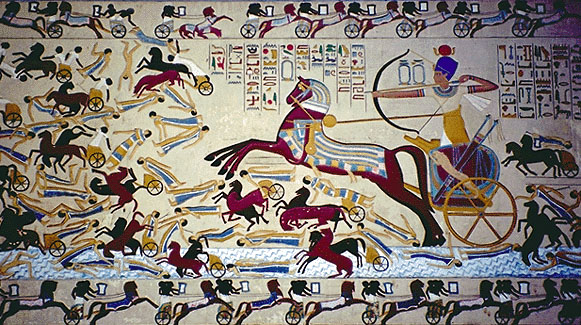It looks like you're using an Ad Blocker.
Please white-list or disable AboveTopSecret.com in your ad-blocking tool.
Thank you.
Some features of ATS will be disabled while you continue to use an ad-blocker.
share:
originally posted by: undo
originally posted by: Spider879
a reply to: undo
But Seti and Abe live about a thousand yrs plus apart,the era of the proto Israelite journey
would be set in the middle kingdom 11th or 12th dynasties .
oh i'm not saying seti I was the pharaoh at the time of abe. to determine the pharaoh, we would have to determine abe's timeframe. to do that, we have to accept that the hyksos were the habiru (israelites) and then locate the event of the exodus as the same event as the expulsion of the hyksos.
The Hyksos which included proto Hebrews would corrispond to the 14 -16 th dynasties it was in that time frame the name Semetic sounding name Yaqub-Har appeared during the 16th?? dynasty of the Hyksos,
In any case the Proto Hebrews would appear at around the 11th or 12th dyn.
edit on 10-6-2014 by Spider879 because: (no reason given)
originally posted by: Spider879
originally posted by: undo
originally posted by: Spider879
a reply to: undo
But Seti and Abe live about a thousand yrs plus apart,the era of the proto Israelite journey
would be set in the middle kingdom 11th or 12th dynasties .
oh i'm not saying seti I was the pharaoh at the time of abe. to determine the pharaoh, we would have to determine abe's timeframe. to do that, we have to accept that the hyksos were the habiru (israelites) and then locate the event of the exodus as the same event as the expulsion of the hyksos.
The Hyksos which included proto Hebrews would corrispond to the 13-14 th dynasties it was in that time frame the name Semetic sounding name Yaqub-Har appeared during the 16th?? dynasty of the Hyksos,
In any case the Proto Hebrews would appear at around the 11th or 12th dyn.
i bet we could narrow it down even further to find who nuked sodom and gomorrah, or at the very least, who had the ear of some powerful non-human or non-earth bound, forces, who did the deed. i mean lot's wife turned into a pillar of salt. every molecule of water, sucked right out of her body. what kind of bomb would do that?
to get it back on topic (sorry, i tend to think outloud)
i have seen some excellent videos about the kemites buildings. i personally think they are the ancestors and descendants of ham, and that they occupied egypt before the black sea flood AND after the black sea flood. i'll see if i can find the videos. you may have already seen them if you've been studying the kemites.
i have seen some excellent videos about the kemites buildings. i personally think they are the ancestors and descendants of ham, and that they occupied egypt before the black sea flood AND after the black sea flood. i'll see if i can find the videos. you may have already seen them if you've been studying the kemites.
originally posted by: undo
look at this. this is pharaoh ahmose (mose (moses) was named after him)
expelling the hyksos. look at the water. it's full of charioteers and presumably a few hyksos as well
I am not sure that ^^was the Hyksos being expelled that looks to be Libyans by their dress however some do have the typical Levantine dress or west-Asiatic dress.will have to double check that.
a reply to: Spider879
nope not libyans. look at their skin color. joseph's coat of many colors, too.
i think that whole idea came from something i read from one of the philosophers, who said he had seen one of the famous ziggurats in mesopotamia and that the stones of their stairs up to the top, were painted in the colors of the rainbow (light spectrum). this, based on my theory that the habiru (hebrews) were the temple builder architects. they were trained in architecture, and this is why nimrod (akkadian enmerkar, egyptian narmer), was a temple builder himself. what the light spectrum would have to do with it all, is a different subject of course.
nope not libyans. look at their skin color. joseph's coat of many colors, too.
i think that whole idea came from something i read from one of the philosophers, who said he had seen one of the famous ziggurats in mesopotamia and that the stones of their stairs up to the top, were painted in the colors of the rainbow (light spectrum). this, based on my theory that the habiru (hebrews) were the temple builder architects. they were trained in architecture, and this is why nimrod (akkadian enmerkar, egyptian narmer), was a temple builder himself. what the light spectrum would have to do with it all, is a different subject of course.
a reply to: Spider879
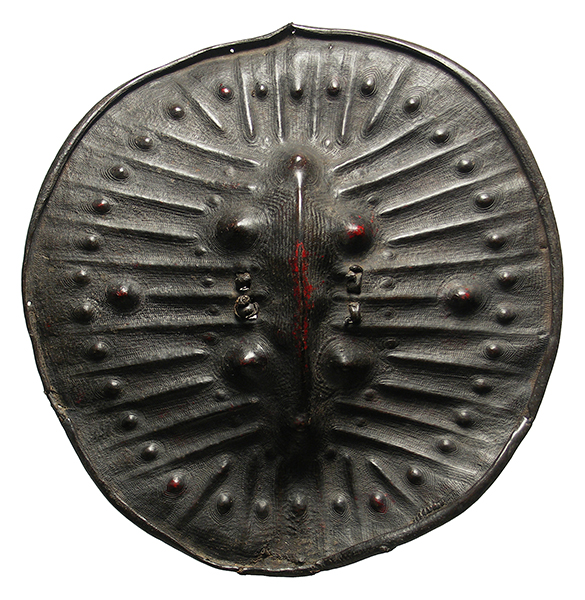
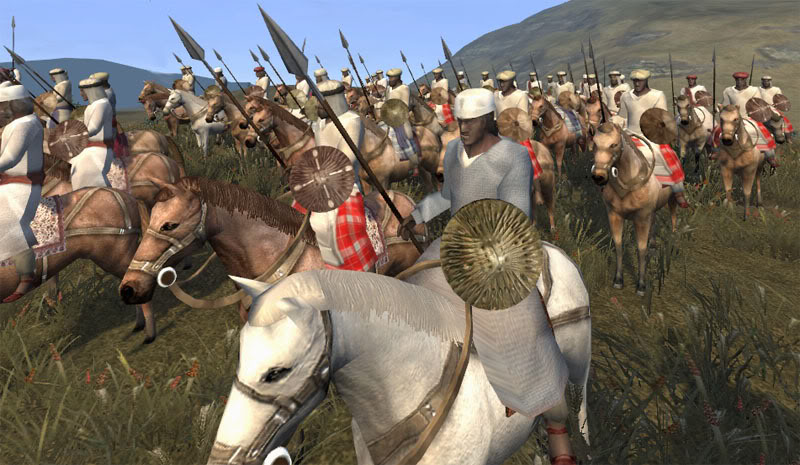
This Ethiopian shield is made from a very thick, tough leather, said to be hippopotamus hide. It was stretched and hammered over an elaborate wood form, dried and removed. The handle is fastened on with leather strips.
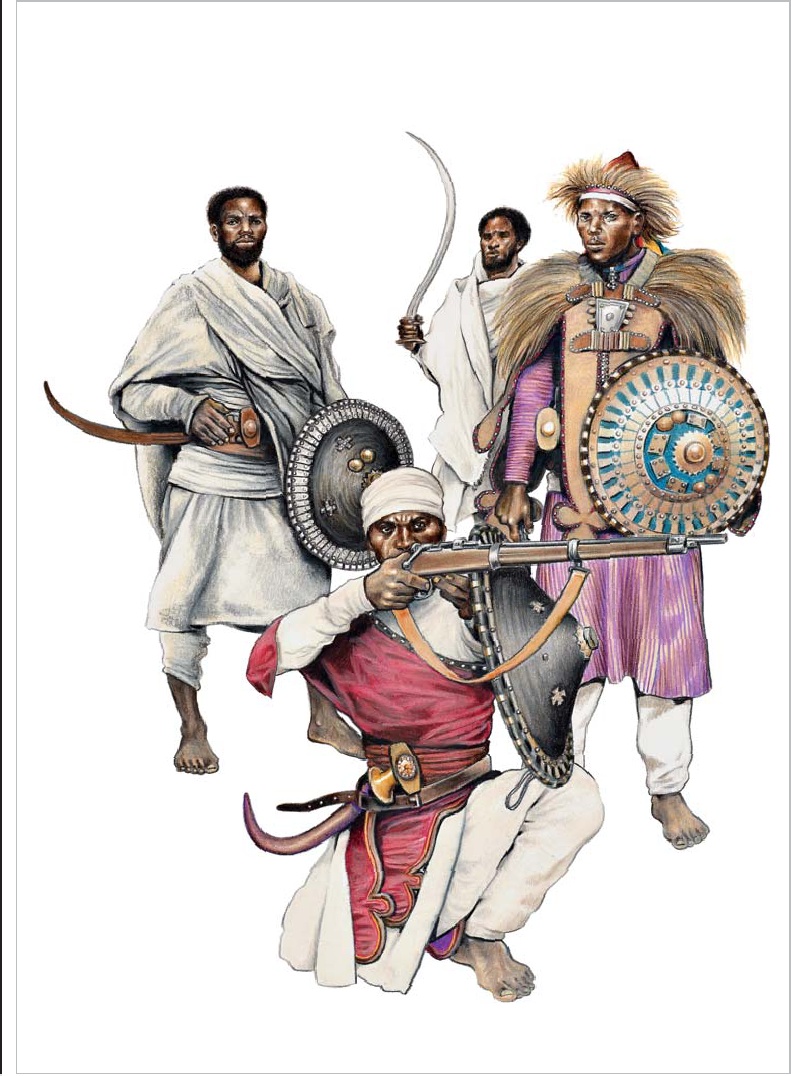
Axumite or Ethiopian army the gun off-course was a later introduction perhaps beginning with the Portuguese who were seeking Christian allies to fight the Muslims,the Axumite had one of the most skillful armies in Africa maintaining it's independence until the invasion of the Italians back in the 30ts,It put out the last of the Pharaohnic rule in Meroe putting an end to the old gods and way of life forever,they burst on to the scene in this manner.
INSCRIPTION OF KING EZANA OF AXUM
www2.stetson.edu...
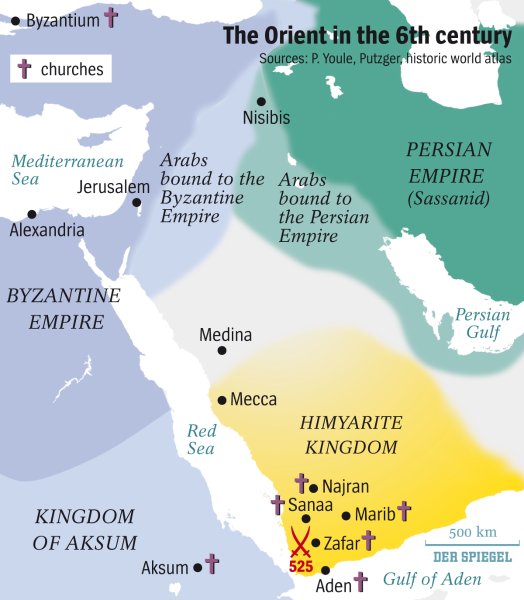
They would cross the Red Sea and and took over the Himyarite Kingdom,ruled by Jews who were hard on Christians at the time burning them in their churches and defecating on the alter this disturbed the Byzantine Romans who asked the Axumites to intervene,they were at the time known as one of the four great world powers the others being,Rome,Persia and China.
More to come:


This Ethiopian shield is made from a very thick, tough leather, said to be hippopotamus hide. It was stretched and hammered over an elaborate wood form, dried and removed. The handle is fastened on with leather strips.

Axumite or Ethiopian army the gun off-course was a later introduction perhaps beginning with the Portuguese who were seeking Christian allies to fight the Muslims,the Axumite had one of the most skillful armies in Africa maintaining it's independence until the invasion of the Italians back in the 30ts,It put out the last of the Pharaohnic rule in Meroe putting an end to the old gods and way of life forever,they burst on to the scene in this manner.
INSCRIPTION OF KING EZANA OF AXUM
Through the might of the Lord of All I took the field against the Noba [Nubians] when the people of Noba revolted, when they boasted and "He will not cross over the Takkaze," said the Noba, when they did violence to the peoples Mangurto and Hasa and Barya, and the Black Noba waged war on the Red Noba and a second and a third time broke their oath and without consideration slew their neighbors and plundered our envoys and messengers whom I had sent to interrogate them, robbing them of their possessions and seizing their lances. When I sent again and they did not hear me, and reviled me, and made off, I took the field against them. And I armed myself with the power of the Lord of the Land and fought on the Takkaze at the ford of Kemalke. And thereupon they fled and stood not still, and I pursued the fugitives twenty-three days slaying them and capturing others and taking plunder from them, where I came; while prisoners and plunder were brought back by my own people who marched out; while I burnt their towns, those of masonry and those of straw, and seized their corn and their bronze and the dried meat and the images in their temples and destroyed the stocks of corn and cotton; and the enemy plunged into the river Seda, and many perished in the water, the number I know not, and as their vessels foundered a multitude of people, men and women were drowned. . .
And I arrived at the Kasu [Kush], slaying them and taking others prisoner at the junction of the rivers Seda and Takkaze. And on the day after my arrival I dispatched into the field the troop of Mahaza and the Damawa and Falha and Sera up the Seda against the towns of masonry and of straw; their towns of masonry are called >Alwa, Daro. And they slew and took prisoners and threw them into the water and they returned safe and sound, after they had terrified their enemies and had conquered through the power of the Lord of the Land. And I sent the troop Halen and the troop Laken and the troop Sabarat and Falha and Sera down the Seda against the towns of straw of the Noba and Negues; the towns of masonry of the Kasu which the Noba had taken were Tabito, Fertoti; and they arrived at the territory of the Red Noba, and my people returned safe and sound after they had taken prisoners and slain others and had seized their plunder through the power of the Lord of Heaven. And I erected a throne at the junction of the rivers Seda and Takkaze, opposite the town of masonry which is on this peninsula.
www2.stetson.edu...

They would cross the Red Sea and and took over the Himyarite Kingdom,ruled by Jews who were hard on Christians at the time burning them in their churches and defecating on the alter this disturbed the Byzantine Romans who asked the Axumites to intervene,they were at the time known as one of the four great world powers the others being,Rome,Persia and China.
More to come:
edit on 10-6-2014 by Spider879 because: (no reason given)
a few more. the idea i'm establishing here is that khemitians/kemites/hamites, were alot more advanced than you've been lead to believe
serapeum
serapeum
Hi Undo I would like to move away from Kmt to other nations will love to revisit their technological prowess of at a later date,that saying you did
remind me to post something on the Buhen fort.
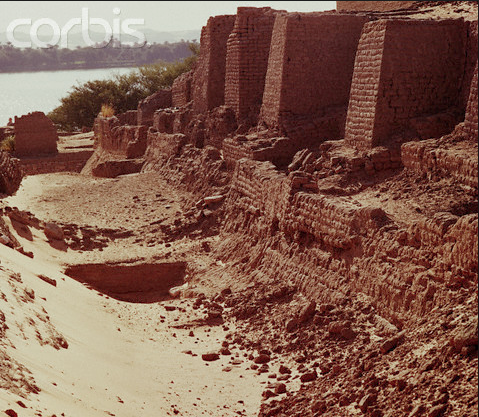
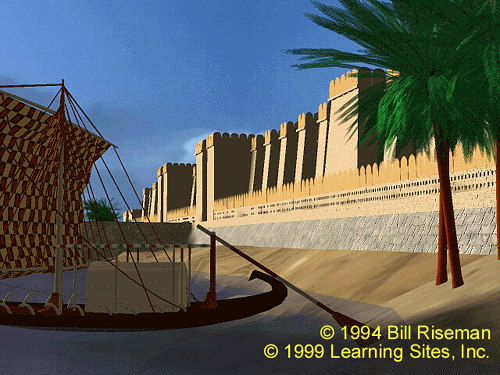
Actually there was a string of such forts built to keep the Kush at bay ,by 12th-Dynasty ruler Sesostris III,the fortress had all the features of a medieval fort,such as draw bridges,watch towers built on an incline with the Nile acting as a moat,but as impressive as it was,like the great wall of China it was only as good as the people who manned or governed it,for it did changed hands to the very people it was meant to keep at bay.


Actually there was a string of such forts built to keep the Kush at bay ,by 12th-Dynasty ruler Sesostris III,the fortress had all the features of a medieval fort,such as draw bridges,watch towers built on an incline with the Nile acting as a moat,but as impressive as it was,like the great wall of China it was only as good as the people who manned or governed it,for it did changed hands to the very people it was meant to keep at bay.
edit on 10-6-2014 by Spider879 because: (no reason given)
isn't it a shame that they just left those buildings to fall apart.
The Horsemen
The horse was domesticated in Eurasia and used along with chariots, both were introduced into Africa by the Hyksos the Kemites,Kush.ites and Libyans were among the first to adopt their use,modifying the chariots to their personal taste, the Kemties preferred a light highly mobile model than the heavy tank like model used in Eurasia ,it is said that the Greeks learnt to hitch four horses to a chariot called quad riggas from the Libyans,perhaps this represents part of the movement of the sea people, refugees of the Trojan war as allies of the Libyans during their attack on Kmt at the time of Merneptah.
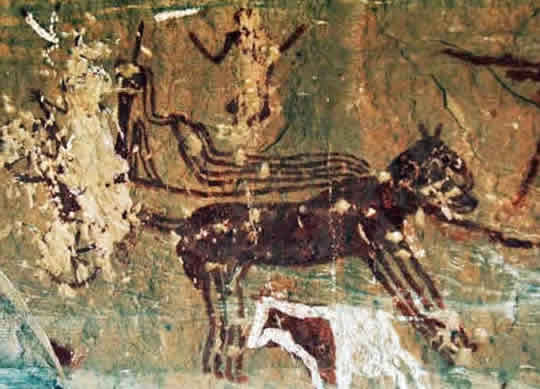
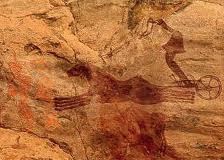
Garamantian charioteers
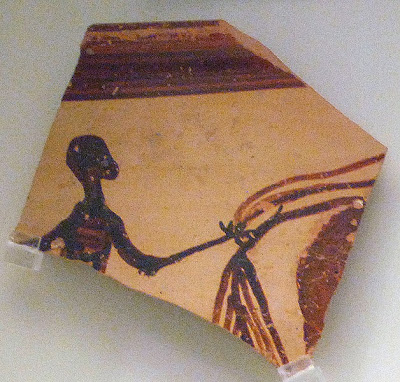
A charioteer: Man of Mycenae (mainland Greece) dated to the 12th century B.C. perhaps a mercenary or ally
The horse would spread as far south as the Niger and adopted there as well,for among the tribes that raided the coast from the interior on horse back were the Nigeritai.
More to come
The horse was domesticated in Eurasia and used along with chariots, both were introduced into Africa by the Hyksos the Kemites,Kush.ites and Libyans were among the first to adopt their use,modifying the chariots to their personal taste, the Kemties preferred a light highly mobile model than the heavy tank like model used in Eurasia ,it is said that the Greeks learnt to hitch four horses to a chariot called quad riggas from the Libyans,perhaps this represents part of the movement of the sea people, refugees of the Trojan war as allies of the Libyans during their attack on Kmt at the time of Merneptah.


Garamantian charioteers

A charioteer: Man of Mycenae (mainland Greece) dated to the 12th century B.C. perhaps a mercenary or ally
The horse would spread as far south as the Niger and adopted there as well,for among the tribes that raided the coast from the interior on horse back were the Nigeritai.
More to come
edit on 10-6-2014 by Spider879 because: (no reason given)
originally posted by: undo
isn't it a shame that they just left those buildings to fall apart.
Well the building of the high dam submerged many and TBH,sometimes old is just old it would take a lot to restore every single site in Egypt to pristine conditions given the fact there is a big problem with poverty and other projects to look after the people of the here and now.
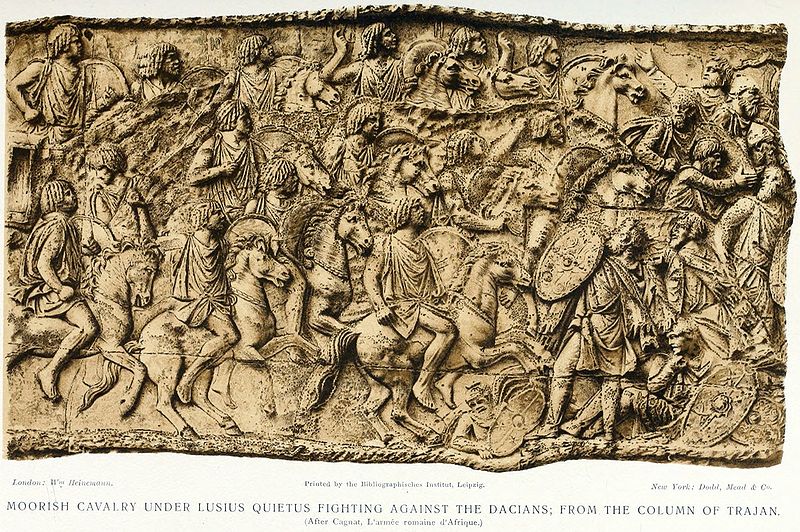
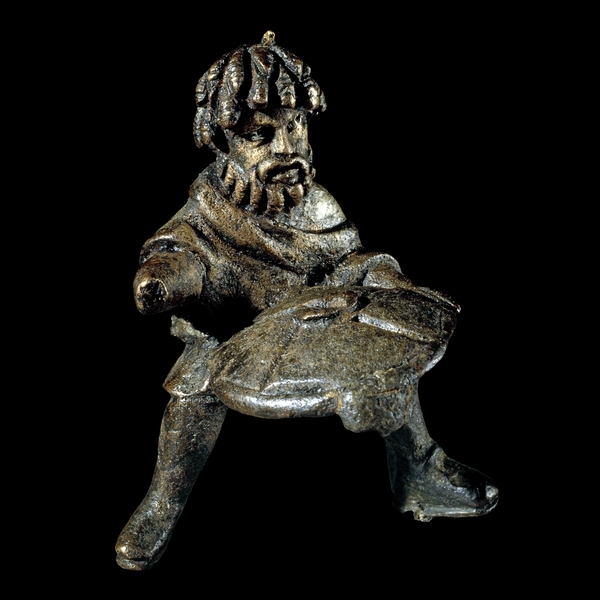
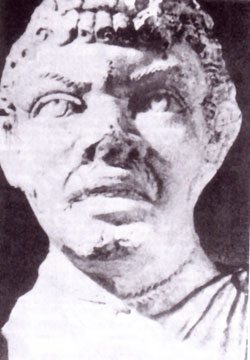
Rome would later make use of these Libyans and African horsemen in general after the defeat of Hannibal,these light horsemen rode bare back without saddles made good use of the bow,javelin and sword they were stationed in many parts of Europe Britain, France, Switzerland, Austria, Poland. The battle for Carthage was truly lost when some of these dreadloc tribesmen switched sides.[/b
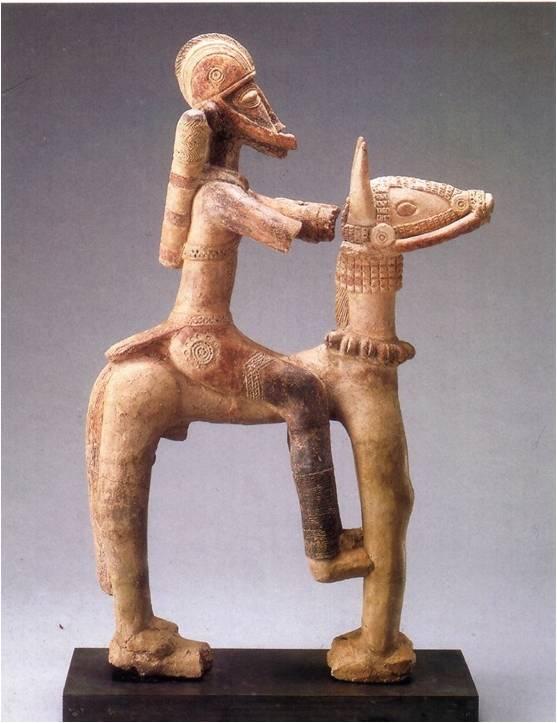
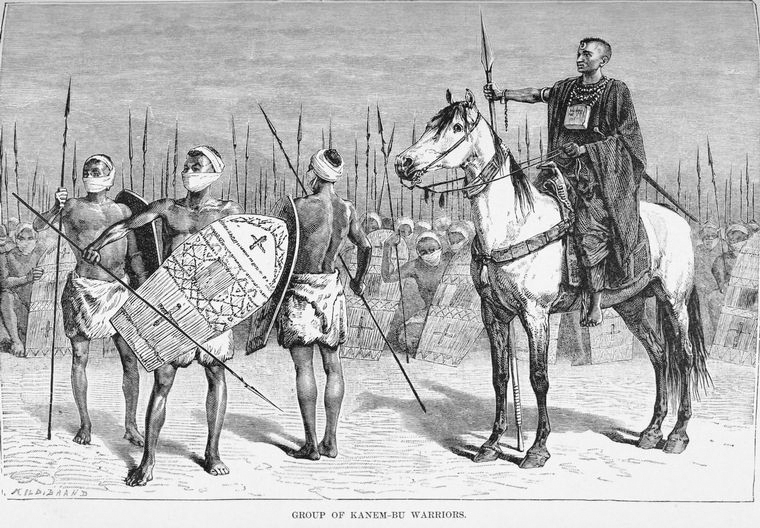
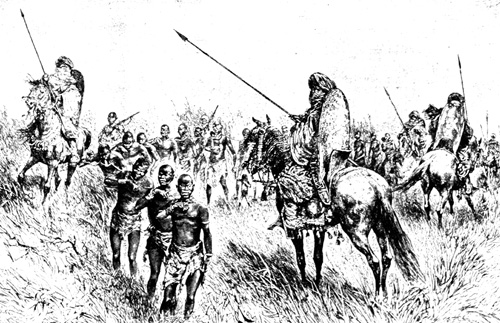
Further south in the grassland empires, horsemen were a major asset it is said that Ghana could field 200,000 men 40,000 archers and cavalry units, later in Mali the emperor had an army of 100,000 men 10,000 were chain-mailed cavalry force.

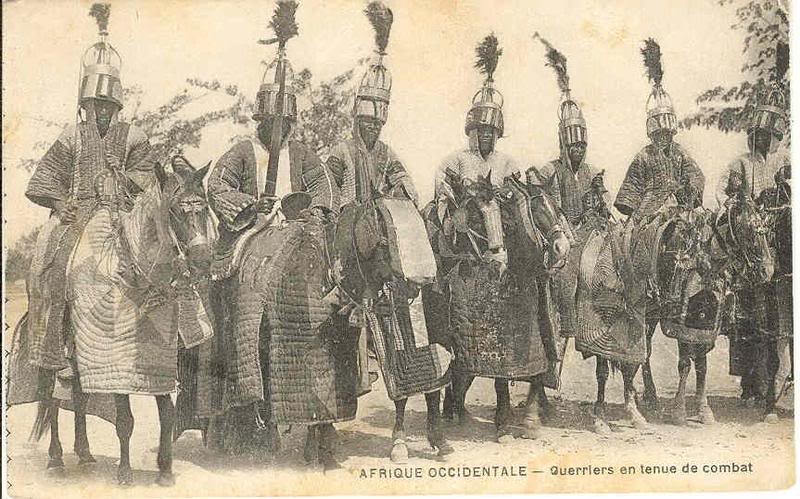
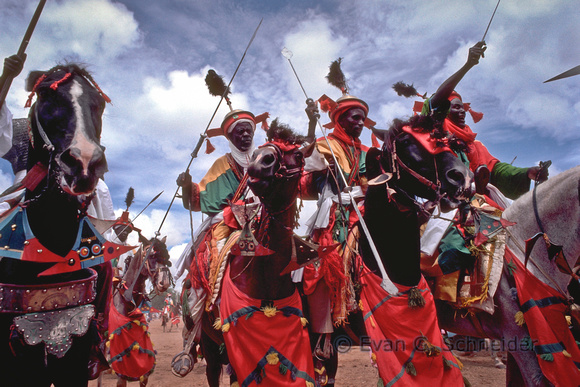
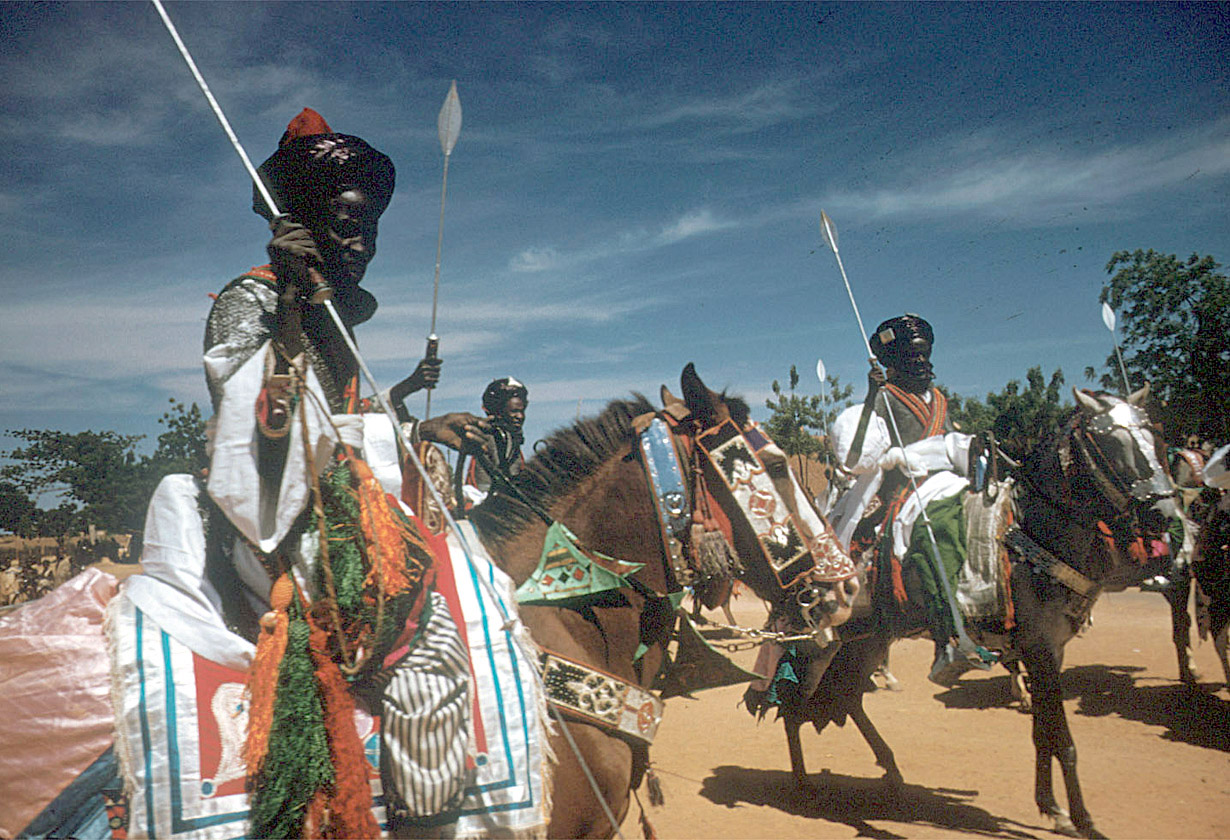
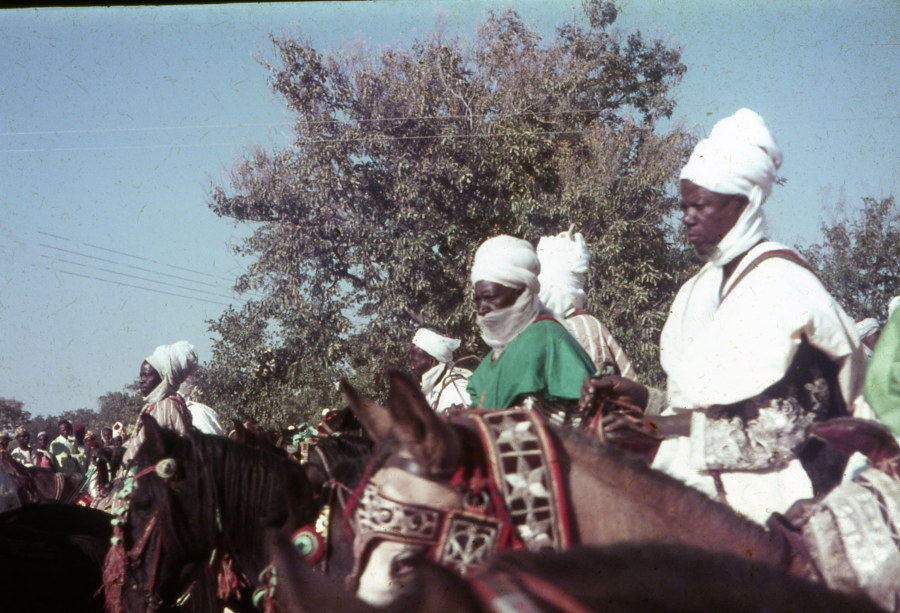
The horsemen would be stalled for the most part at the forest zone where tse flies made life unbearable for horses although some area relatively free of those pest the horsemen continued although limited of use in a forest.
More to come
edit on 10-6-2014 by Spider879 because: (no reason given)
Just in case many are wondering,if all these Savannah states were Muslim,the answer to that is alot of them were but they existed way before Islam was
introduced to the area ,some were contemporaries of 1st dyn kmt ,owning nothing of their state craft or organizations to Muslims some didn't even
bother to convert their courts ,like the ancient Ghanaians known as Wagadugu some remained powerful enough to extract tribute from Muslim and non
Muslims alike,the horse as in most places around the world became a symbol of military prestige:
A History of African Societies to 1870 Paperback
by Elizabeth Isichei (Author)
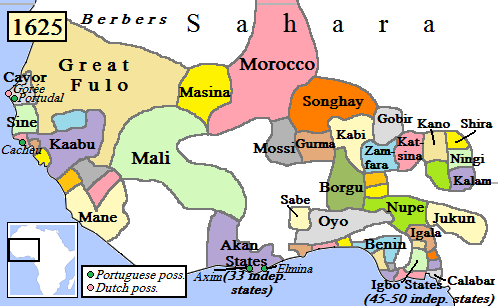
Into The Forest Zone
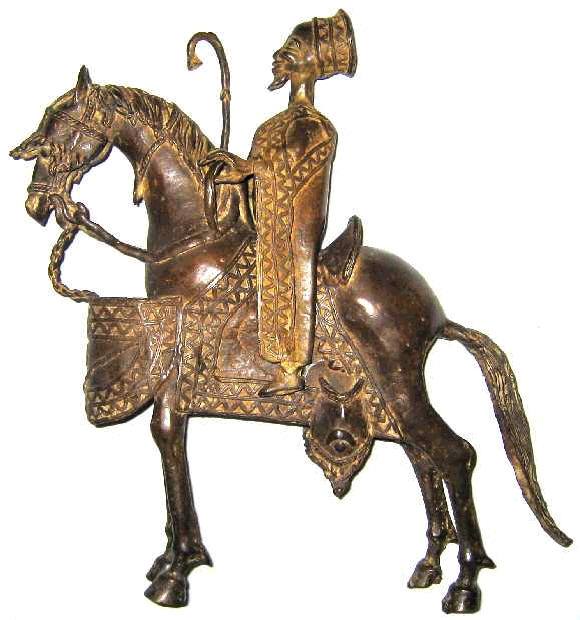
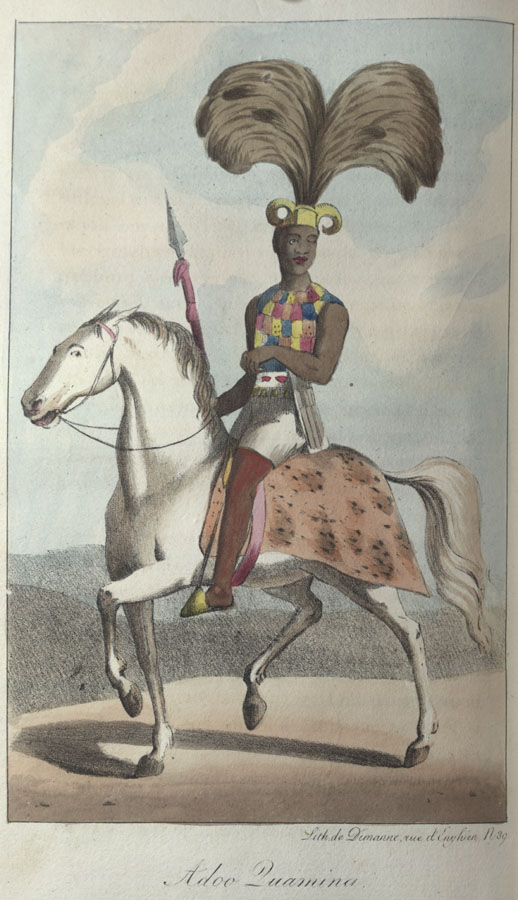
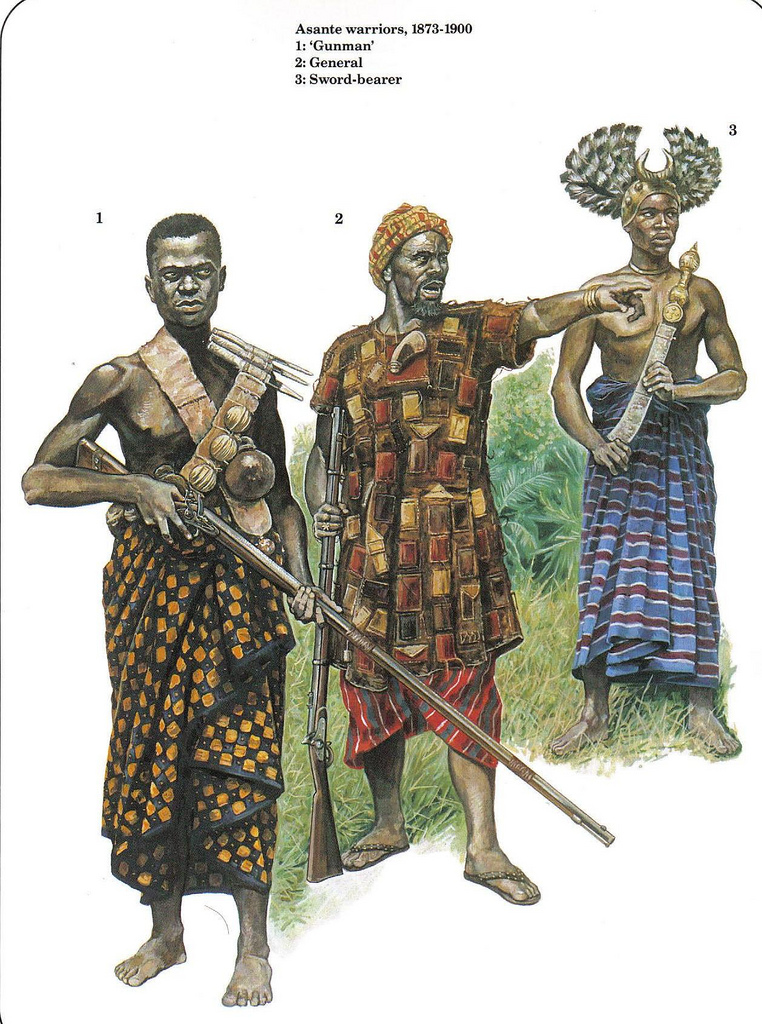
Ashanti Commanders and soldiers 1800
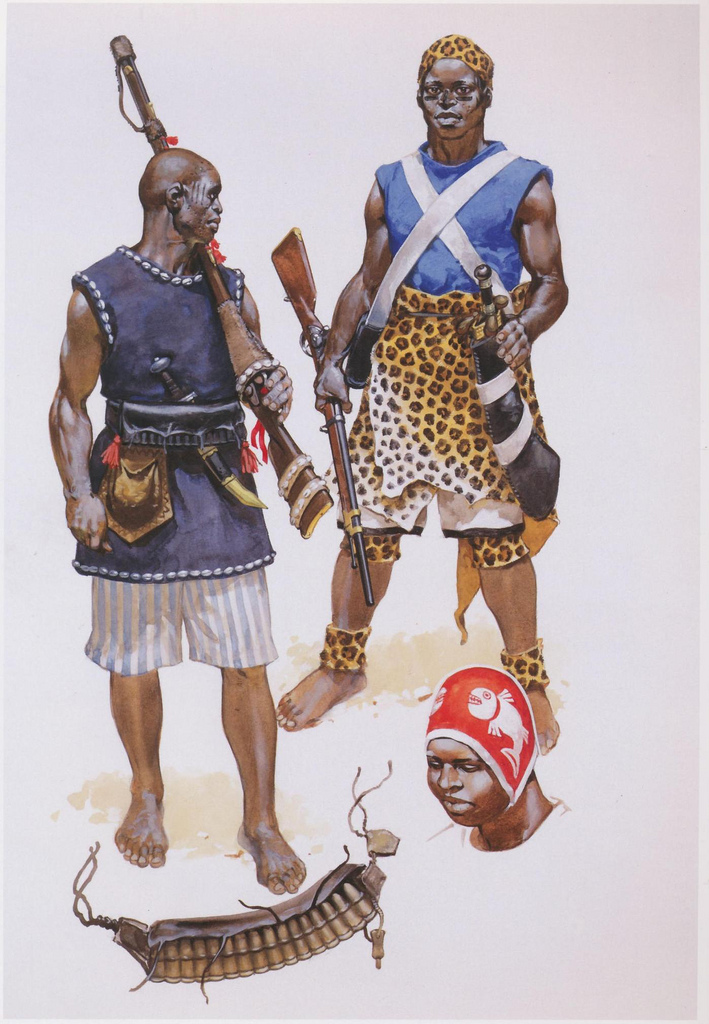
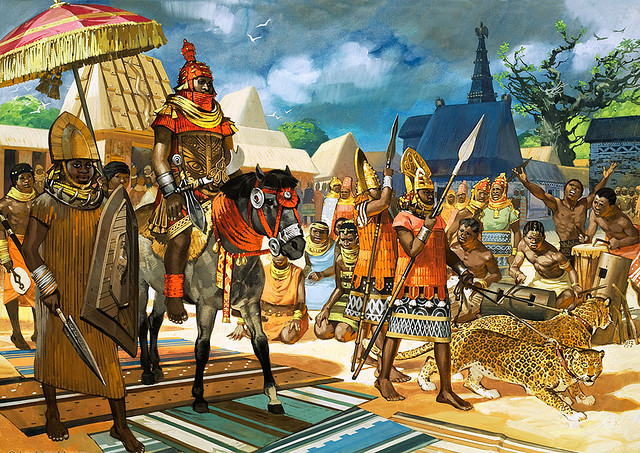
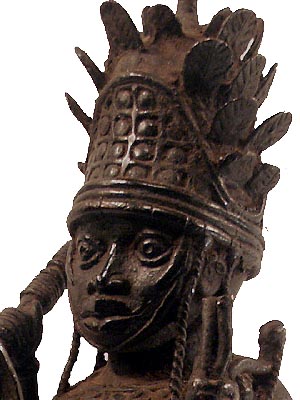
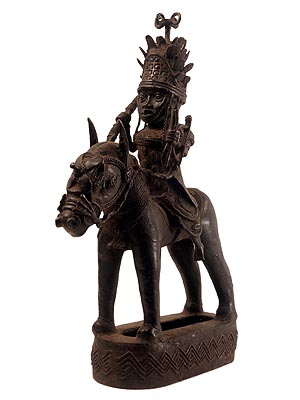
Benin soldiers at court with king and body guards
A History of African Societies to 1870 Paperback
by Elizabeth Isichei (Author)
"The king of Zafun is stronger than the veiled people of the Maghreb and more versed in the art of kingship. The veiled people acknowledge his superiority over them, obey him and resort to him in all important matters of government. One year the king, on his way to the pilgrimage, came to the Maghreb to pay a visit to the commander of the Muslims, the veiled king of the Maghreb, of the tribe of Lamtuna. The Commander of the Muslims met him on foot, whereas the king of Zafun did not dismount for him. He was tall, of deep black complexion and veiled."

Into The Forest Zone



Ashanti Commanders and soldiers 1800




Benin soldiers at court with king and body guards
edit on 11-6-2014 by Spider879 because: (no reason given)
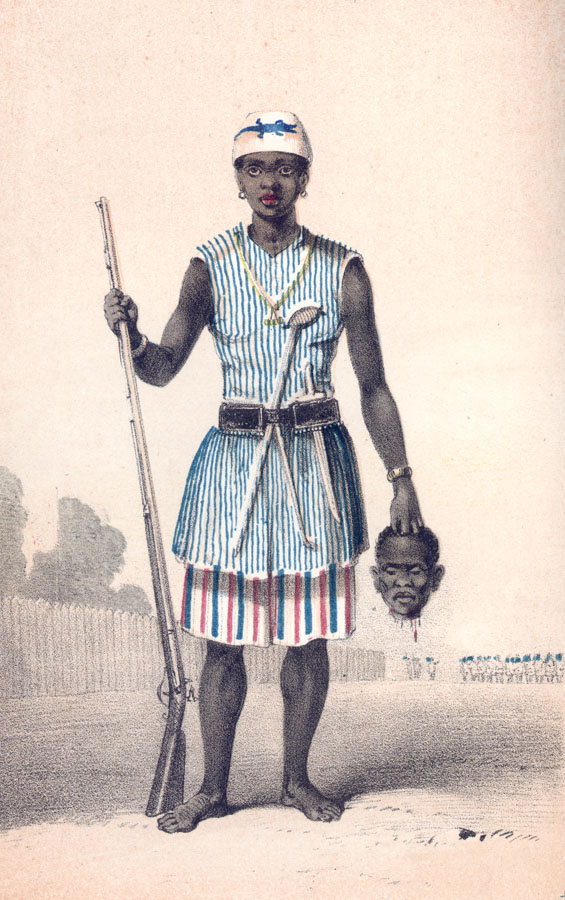
Seh-Dong-Hong-Beh leader of the Amazons
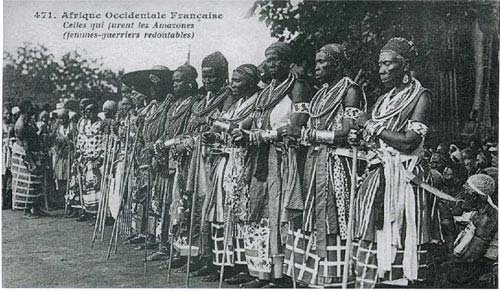
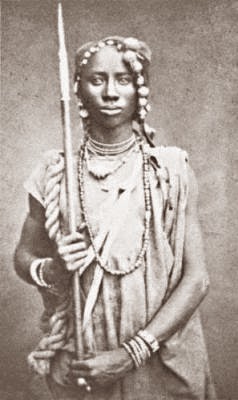
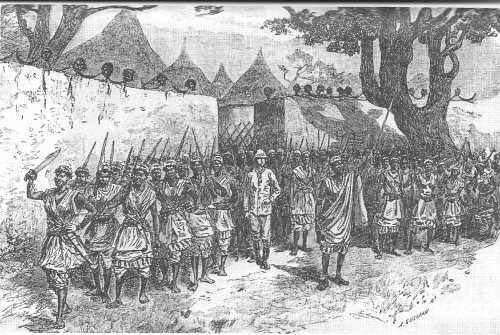
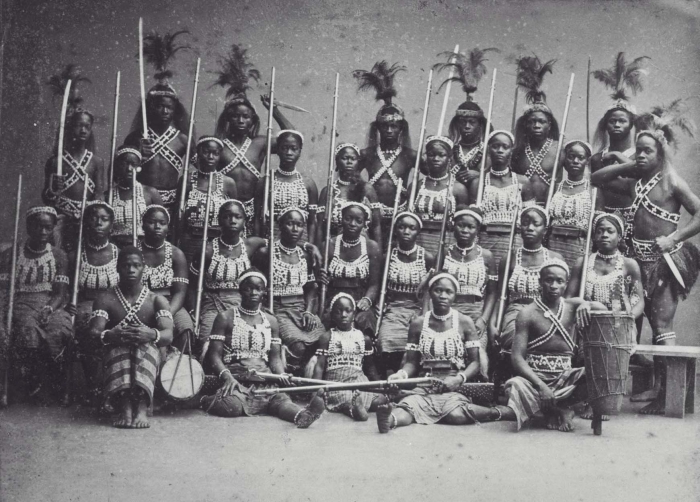
Mixed company taken after their final battle with the French
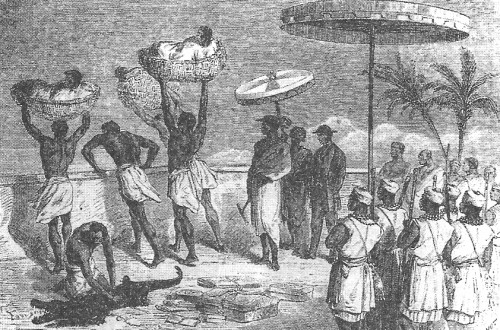
This pic from my book is labeled Insensitivity training .
Cannot be over looked the Amazons of Dahomey also known as the king's wives,had their own units they were often more feared then the men with whom they were encouraged to compete.
The women soldiers were rigorously trained, given uniforms, and equipped with Danish guns (obtained via the slave trade).[citation needed] By the mid-19th century, they numbered between 1,000 and 6,000 women, about a third of the entire Dahomey army, according to reports written by visitors. The reports also noted variously that the women soldiers suffered several defeats, but that the women soldiers were consistently judged to be superior to the male soldiers in effectiveness and bravery.
The women soldiers were said to be structured in parallel with the army as a whole, with a center wing (the king's bodyguards) flanked on both sides, each under separate commanders. Some accounts note that each male soldier had a mino counterpart.
In the latter period, the mino were armed with Winchester rifles, clubs and knives. Units were under female command. Captives who fell into the hands of the mino were often decapitated
Wiki sourced but the info is the same from a book in my collection Amazons Of Black Sparta .
There is more I could add but let me make one thing clear as much as I admire them for their military histories I am torn by the fact that these were among the most vicious slave hunters and dealers in history,Europeans did not walk in to Africa and start snatching people,during the era of empire building and expansion Europeans happened to came to them for trade,at first they grabbed a few people from the coast but the response was swift ,even at sea Cadamosto and his crew narrowly escaped getting boarded by massive ocean going canoes,on the river they did capture European vessels,so until the time of the repeating rifles Europeans stayed on the coast paying rent to African kings to set-up slave forts,they were not enticed into doing so it was all business and all involved made a profit.
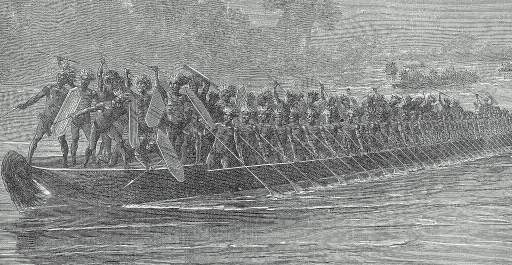
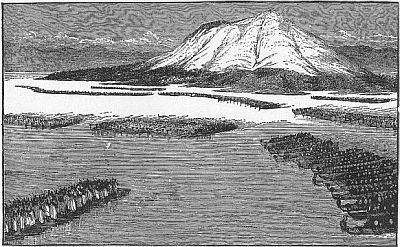
Buganda War Canoes
edit on 11-6-2014 by Spider879 because: (no reason given)
OK I am done please read hopefully enjoy ,comment ,critique ,add more info if any asked questions.
a reply to: Spider879
Hey there spider,
S&F
Nice post, I appreciate your effort and knowledge on such things African.
On an unrelated side note, are you aware of the proposed link between Dravidian and Niger-Congo? If not pm me and I'll send you a link to some of the literature. Evidently the millet grown by the people of the indus valley civilization, was an African variety. And there are niger-Congo loan words in Dravidian.
Hey there spider,
S&F
Nice post, I appreciate your effort and knowledge on such things African.
On an unrelated side note, are you aware of the proposed link between Dravidian and Niger-Congo? If not pm me and I'll send you a link to some of the literature. Evidently the millet grown by the people of the indus valley civilization, was an African variety. And there are niger-Congo loan words in Dravidian.
originally posted by: punkinworks10
a reply to: Spider879
Hey there spider,
S&F
Nice post, I appreciate your effort and knowledge on such things African.
On an unrelated side note, are you aware of the proposed link between Dravidian and Niger-Congo? If not pm me and I'll send you a link to some of the literature. Evidently the millet grown by the people of the indus valley civilization, was an African variety. And there are niger-Congo loan words in Dravidian.
Please do,I was always critical of claims made by some that Dravidians were some how Africans but I'd be interested to see just how the millet got there. thanks
a reply to: Spider879
Spider,
I too am skeptical of some of the claims of this particular author, but on this one he's not the only one who make a case.
dienekes.blogspot.com...
Spider,
I too am skeptical of some of the claims of this particular author, but on this one he's not the only one who make a case.
@ Nathan who said:
"I have never seen any academic journal claiming Dravidian has any connection to African languages. All sources on Dravidian linguistics limit the language group to the SubContinent. The exception is McAlpin's hypothesis. "
Many researchers have written on the relationship between the Dravidian and Niger-Congo including : Dr. Balakrishnan, Dr. Upadhyaya and Dr. Upadhyaya; Dr. Aravaanan who are Dravidian speaking linguist, the French linguist L. Homburger and Sergent .
Articles on this linguistic relationship has appeared in BioEssay, International Journal of Dravidian linguistics, PILC Journal of Dravidian Studies, Bull. De L’IFAN, Journal de la Societe des Africanists, Journal Afrique and Kemi. These researchers maintain that Dravidian languages are genetically related to Niger-Congo languages. Below is a partial list of articles denoting this fact:
You claim that Dravidian is not related to the Niger-Congo group. But numerous linguist say the language families are related.
Aravanan, K P , "Physical and cultural similarities between Dravidians and Africans", Journal of Tamil Studies 10,(1976)pages 23-27.
Aravanan, K P. (1979). Dravidians and Africans , Madras.
Aravanan,K.P. Notable negroid elements in Dravidian India, Journal of Tamil Studies, 1980, pp.20-45.
R. Balakrishnan, in 'African Roots of the Dravidian -speaking Tribes,: A Case Study in Onomastics', International Journal of Dravidian Linguistics,(2005) 34(1):153-202
Lal, B , "The Only Asian expedition in threatened Nubia:Work by an Indian Mission at Afyeh and Tumas", The Illustrated London Times , 20 April 1963
Lahovary, N , Dravidian Origins and the West, Madras: Longman,1963.
N'Diaye, C.T. (1978) The relationship between Dravidian languages and Wolof. Annamalai University Ph.D. Thesis.
Sergent , Bernard (1992). Genèse de L'Inde. Paris: Payot .
Singh, H.N. (1982). History and archaeology of Black-and Red ware. Delhi.
Upadhyaya,P & Upadhyaya,S.P., Les liens entre Kerala et l"Afrique tels qu'ils resosortent des survivances culturelles et linguistiques, Bulletin de L'IFAN, no.1, 1979, pp.100-132.
Upadhyaya,P & Upadhyaya,S.P. Affinites ethno-linguistiques entre Dravidiens et les Negro-Africain, Bull.de L’IFAN,No.1, 1976,pp.127-157.
Winters, C.A. (1994). The Dravidian and African languages, International Journal of Dravidian Linguistics, 23 (2), 34-52.
Winters, Clyde Ahmad.(1999a). ProtoDravidian terms for cattle. International Journal of Dravidian Linguistics, 28, 91-98.
Winters, C.A.(1999b). Proto-Dravidian terms for sheep and goats.PILC Journal of Dravidian Studies, 9 (2), 183-87.
Winters, C.A.(2000). Proto-Dravidian agricultural terms. International Journal of Dravidian Linguistics, 30 (1), 23-28.
Winters,C, Did the Dravidian Speakers Originate in Africa?, BioEssays,27(5):497-498 [2007]
Winters,C. African millets taken to India, Ann of Bot [2008], aob.oxfordjournals.org...
Winters,C Origin of the Niger-Congo Speakers. WebmedCentral Genetics 2012,3(3):WMC))3149. www.webmedcentral.com...
dienekes.blogspot.com...
edit on 12-6-2014 by punkinworks10 because: (no reason
given)
a reply to: punkinworks10
Much thanks,I noticed C.A Winters figures predominantly on that list and while I am not a linguist by any stretch of the imagination Winters is a hyper diffusionist who see Mande language every where, spreading right around the globe and is the founders of civilizations from India to Shang era China and the America's, ferchrisakes he believes in something call the Maa confederation which involves the Mande being instrumental in the lost civilization of Lemuria,so yes while he maybe ok on some fronts,I wouldn't use him to bolster any argument or theory I have.
Much thanks,I noticed C.A Winters figures predominantly on that list and while I am not a linguist by any stretch of the imagination Winters is a hyper diffusionist who see Mande language every where, spreading right around the globe and is the founders of civilizations from India to Shang era China and the America's, ferchrisakes he believes in something call the Maa confederation which involves the Mande being instrumental in the lost civilization of Lemuria,so yes while he maybe ok on some fronts,I wouldn't use him to bolster any argument or theory I have.
new topics
-
School shooting in Madison Wi.
Social Issues and Civil Unrest: 4 hours ago -
Prisoner CNN helped free from Syrian prison was actually notorious Assad regime torturer: report
Mainstream News: 5 hours ago -
Labour Plotting to Postpone May's Council Elections ?
Regional Politics: 7 hours ago -
Is this really what is going on?
General Conspiracies: 7 hours ago -
Russias War Against Religion in Ukraine
World War Three: 8 hours ago -
iPhone Microphone Being Accessed by Unknown App
The Gray Area: 10 hours ago
top topics
-
iPhone Microphone Being Accessed by Unknown App
The Gray Area: 10 hours ago, 10 flags -
Is this really what is going on?
General Conspiracies: 7 hours ago, 10 flags -
Prisoner CNN helped free from Syrian prison was actually notorious Assad regime torturer: report
Mainstream News: 5 hours ago, 8 flags -
School shooting in Madison Wi.
Social Issues and Civil Unrest: 4 hours ago, 7 flags -
Democrats send letter to Biden urging him to ratify Equal Rights Amendment
US Political Madness: 16 hours ago, 4 flags -
Russias War Against Religion in Ukraine
World War Three: 8 hours ago, 4 flags -
Labour Plotting to Postpone May's Council Elections ?
Regional Politics: 7 hours ago, 3 flags
active topics
-
School shooting in Madison Wi.
Social Issues and Civil Unrest • 21 • : TruthJava -
Drones everywhere in New Jersey ---and Elsewhere Master Thread
Aliens and UFOs • 191 • : nugget1 -
Prisoner CNN helped free from Syrian prison was actually notorious Assad regime torturer: report
Mainstream News • 3 • : BeyondKnowledge3 -
Russias War Against Religion in Ukraine
World War Three • 9 • : NorthOS -
Democrats send letter to Biden urging him to ratify Equal Rights Amendment
US Political Madness • 10 • : bluesman023 -
Is this really what is going on?
General Conspiracies • 41 • : fringeofthefringe -
Defending the need for adherence to Old Testament commandments under the new covenant of Christ
Conspiracies in Religions • 33 • : lilzazz -
-@TH3WH17ERABB17- -Q- ---TIME TO SHOW THE WORLD--- -Part- --44--
Dissecting Disinformation • 3719 • : Thoughtful3 -
iPhone Microphone Being Accessed by Unknown App
The Gray Area • 2 • : VictorVonDoom -
Post A Funny (T&C Friendly) Pic Part IV: The LOL awakens!
General Chit Chat • 7917 • : KrustyKrab

